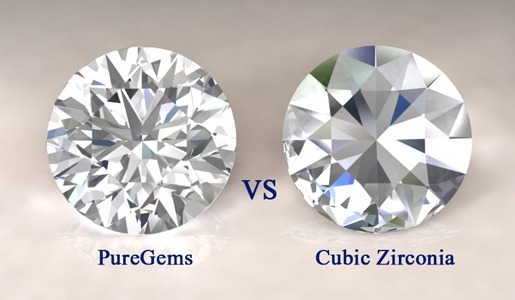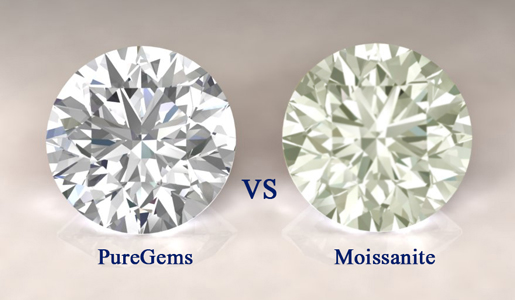Beautiful, Flawless, Brilliant
Our simulant diamonds are crafted by modern science to be colorless and nearly flawless, earning them the distinction as the finest simulant diamonds globally.
Simulant diamonds have all the same brilliance and shine as natural diamonds. For many years they have been sought after for scientific research, as they have the same incredible hardness and ability to cut glass as natural diamonds and can be shaped into the same styles and facets. While a natural diamond of the same carat, clarity, and color might cost a buyer tens of thousands of dollars, our lab created-simulated diamonds with the same VVS1 rating are a fraction of the cost. Expert jewelers agree that to the naked eye, it is practically impossible to tell the difference between a natural diamond and a Pure Gems diamond simulants. If anything, Pure Gems diamonds are too perfect. Because they are created in a lab, Pure Gems diamond simulants have no imperfections or inclusions, only beautiful brilliance, clarity, and shine.


Cubic Zirconia
Cubic Zirconia has long been considered the cheapest alternative to diamonds. However, because CZ is made from a soft, very porous mineral, it can chip and scratch easily. It also absorbs dirt and oil from the environment and your own skin, causing the stone to get cloudy and milky colored over time. Eventually, cubic zirconia can become yellow, losing its brilliance and fire. Most CZ are cut to mimic popular diamond styles, but the soft stone can cause edges to be rounded instead of sharp, which also changes its ability to refract light. While CZ is a popular choice for cheap fashion jewelry, it is not a stone with a long lifetime.
Moissanite
Another popular diamond alternative is Moissanite. While it has a higher index of brilliance and refraction than other stones, unfortunately Moissanite is made of a different material—silicon carbide. Because of this, it cannot be cut in the same styles as a diamond. Moissanite is also double refracting because of its hexagonal crystal structure, so Moissanite stones have to be cut along a different axis, with different proportions than a diamond. While most high quality diamonds and simulant diamonds are almost completely colorless, Moissanite stones often have a peculiar light yellow hue that becomes much more obvious in indoor or fluorescent lighting.
How are they made?
When diamond simulants are grown in a lab like our Pure Gem diamonds, they are created using a process called “skull melt.” Despite the grim name, what this means is the materials are melted from the inside out, creating a hard shell or crust, which is referred to as the “skull.” It takes massive amounts of extreme heat to create a cube form, which is the optimal structure. A metal oxide stabilizer is added to the materials to encourage the cubic crystals to grow. Once the heat is turned off, the stone cools and hardens, forming the crystals. Because they are grown in a lab under the watchful eye of experts, these resulting crystals are perfect, without imperfection or inclusion, and with the same hardness as natural diamonds. Because they have the same hardness, man made diamond simulants can be cut the same way as natural ones, with many facets and in the correct proportions to encourage their brilliance to shine through.
Of course, every simulant diamond can vary slightly from stone to stone. For this reason, we give our measurements in a range for color, hardness, and gravity:
Color: D – F (on the diamond scale)
Hardness: 8.5 – 8.6 (Mohs hardness scale)
Specific Gravity: (5.8 – 6.0)
Crystal Form: (Isometric)
Brilliance: Excellent (7.40)
Refractive Index: (2.20)
Dispersion: (0.56)
As more and more companies have tried to move into the man-made diamond market, different processes have been attempted. Consumers might see the products marketed as DLC (Diamond-Like Carbon) or Amorphous Diamond, where cubic zirconia is “diamond plated” with DLC. There is even a technique called “Vacuum Sputtering” where cheap stones are coated with a layer of metal oxide to create an iridescent effect. These stones are sometimes labeled “Mystic,” and the metal oxide layer can scratch off and chip easily.
What all these processes have in common is that none of them create their stones from pure carbon, which means that none of them have the same mineral composition as a natural diamond. Of course, if they did, their products would cost just as much as a natural diamond. While all these companies are constantly pushing their innovations to try and mimic the refractive index and structure of a natural diamond as much as possible, the really important difference in products comes down to the final step: cutting and polishing. This is where the finished stone really shines.
Pure Gems lab-created diamond simulants are cut and polished by experts with years of experience in the jewelry industry. The type and number of facets cut into the stone determines its final refractions, which in turn creates the fluorescence, sparkle, and fire that we love diamonds for. Because our simulant diamonds are almost as hard as a natural diamond, we are able to polish and cut the stones into beautiful gems that are nearly indistinguishable from the real thing. This is why we offer our lifetime warranty on every stone, because we are confident that our stones will not fade, yellow, or lose their brilliance.
See for yourself why Pure Gems Simulant Diamonds are the choice of savvy buyers across the world.

